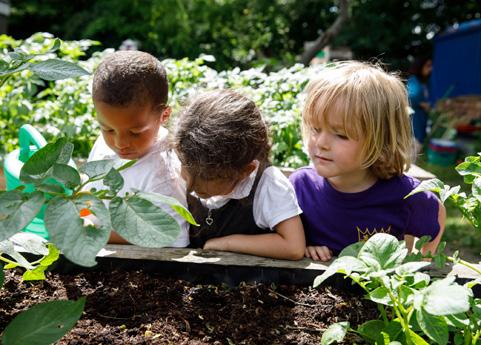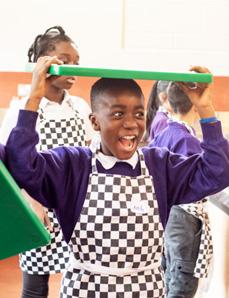
2 minute read
CREATING A SCHOOL OF FOOD
4.0 INITIAL PLANNING
Creating your own School of Food is an exciting and rewarding project. However you’d like your School of Food to look, there’s a scale that will work for you and benefit your school.
Advertisement
The first step is to bring food and food education into focus within day-to-day school life. Before embarking on the School of Food, LEAP Federation and Chefs in Schools worked together to radically improve the food culture in LEAP schools.
4.2 4.1 START SMALL CHANGE THE CULTURE
Tips for changing a school’s food culture:
Ensure your school kitchen team are confident to talk with children about their food – every visit to the dining hall is an education. Create or sign up to a school food charter, include pupils and the kitchen team in the project.
Grow a few herbs or vegetables that children can nurture and then deliver to the kitchen.

Growing your own school produce is a great way to start getting kids involved in a hands-on way. A few containers can be used to grow tomatoes or lettuce. If you have space, create a vegetable patch in the playground. Try to involve the kitchen team in any project linked to food.
You can find more advice on vegetable patches and gardening from p.59.
Put edible flowers on the table at lunch. Serve vegetables, like cauliflower, whole. Put pea shoots on the table for kids to pick themselves. Decorate the dining hall with pictures or a mural of vegetables and fruit.
Are you ready to take the first step and change the food culture in your school?

FUNDRAISING TIPS PLANNING SOMETHING BIGGER?
As the food culture in the school is transforming, it’s a good time to start planning for the next step. You’ll need three things to deliver a School of Food.
Space
Is there a space in your school which is rarely or never used?
The Hackney School of Food was a near derelict building. Other options include disused classrooms waiting to be made useful – or space to build a new classroom.
Vision
Who within the school or local community has a passion for food?
Identify those who you can involve to drive the project forward and make your vision a reality. Run focus groups with your pupils, staff and parents to get their input and gather ideas. Compile these ideas into a written brief of what you’re aiming to achieve.
Funding
If you’re planning a large scale project, start by speaking to your local council about local funding opportunities and how they might be able to support you. There will be various pots of funds you can access from local and national grant makers.
Each funder is different and will have specific application requirements but it’s often possible to reuse information from previous bids, which means the application process gets less onerous after a few bids.
Raise awareness – send press releases to local media and keep shouting about the project on social media, this can boost fundraising and attract volunteers with expertise.
Bring your vision to life! We found that funders responded positively when presented with design work, including visualisations of the intended designs. Share the designs on social media and with local papers. The below image is a good example from the Hackney School of Food.

4.4 FUNDRAISING TIPS
Involve Crowdfunding
Involve your school community in fundraising activities; from bake sales to fun runs, there is something for everyone.


Set up a crowdfunding page where you can tell people about your project and encourage them to donate.
REACH OUT WRITE
Reach out to parents and Governors to support your fundraising campaign – you never know who someone might know!
Write to local companies who may be able to donate equipment as well as funds.
STAY UP TO DATE WITH RELEVANT FUNDING OPPORTUNITIES.
The Grants4Schools database is a brilliant free resource to help you find grants specific to educational projects and schools.









